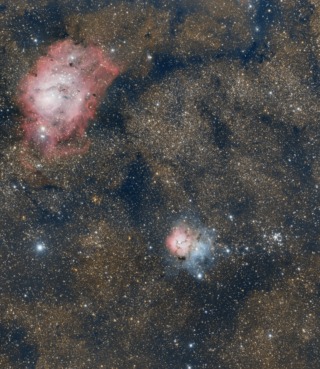
- Constellation: Sagittarius
Wide-field mosaic of Messier 8 The Lagoon Nebula and Messier 20 The Trifid Nebula. Messier 8 is an emission nebula HII region in Sagittarius. Several collapsing clouds know as Bok globules are visible which may eventually collapse down to form new stars. Messier 20 is highlighted by three different types of nebula. The red parts are an emission nebula, the blue parts are a reflection nebula, and the dark bands are dark nebula which are clouds of dust and gas blocking light from behind.
- Details
- Category: Nebulas
- Telescope: EDT 80mm Reftactor
- Camera: ZWO A071 Color
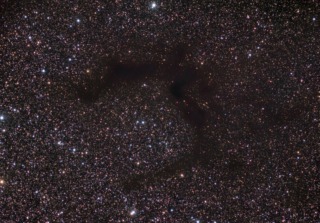
- Constellation: Aquila
- Right Ascension: 19h 40' 44"
- Declination: +10° 51' 0"
- Distance: 2,000
Barnard 143 is a dark nebula consisting of gas and dust that blocks the background stars of our galaxy. Located in Aquila with as estimated distance of 2,000 light years.
- Details
- Category: Nebulas
- Telescope: Explore Scientific 127 Refractor
- Camera: ZWO 1600 MM
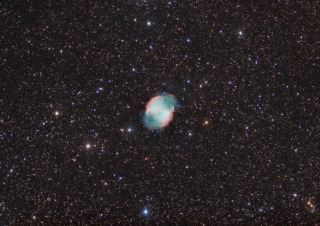
- Constellation: Vulpecula
- Right Ascension: 19h 59m 36.340s
- Declination: +22° 43′ 16.09″
- Distance: 415 ly
Planetary nebula Messier 27, often called the Dumbbell Nebula. Located in the constellation of Vulpecula. The term planetary is a misnomer as it has nothing to do with planets. The outer layer of the star is expelled into space when a star goes through a red giant phase. The outer layers are then ionized by the remaining core as it becomes a white dwarf star. Something our Sun may become near the end of its life cycle.
- Details
- Category: Nebulas
- Telescope: Explore Scientific 127 Refractor
- Camera: ZWO 1600 MM
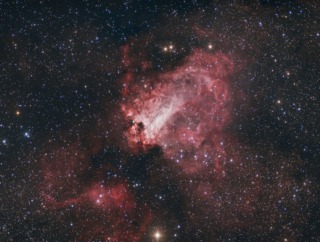
- Constellation: Sagittarius
- Right Ascension: 18h 20m 26s
- Declination: −16° 10′ 36″
- Distance: 5,000+ ly
Messier 17 is a H II region located in Sagittarius. Similar to the Orion Nebula, but more massive and viewed edge on. The main part of the nebula spans some 15 light years and is home to some current 800 stars with many more thousands being born in outer layers. At around 1 million years old, it is forming a young open cluster of stars.
- Details
- Category: Nebulas
- Telescope: Explore Scientific 127 Refractor
- Camera: ZWO 1600 MM
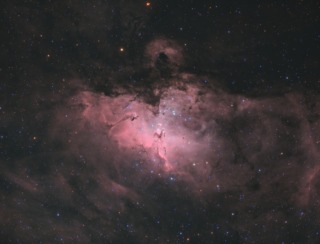
- Constellation: Serpens
- Right Ascension: 18h 18m 48s
- Declination: −13° 49′
- Distance: 7,000 ly
Messier 16 or as commonly call the Eagle Nebula, or Star Queen Nebula is an open cluster and nebula located in the constellation of Serpens. The central spires of dust and gas were made famous by the Hubble's "Pillars of Creation" image. The pillars and other regions of the nebula host new star formation. The central spire is some 9.5 light years in length. The age of the cluster is around 5 million years.
- Details
- Category: Nebulas
- Telescope: Explore Scientific 127 Refractor
- Camera: ZWO 1600 MM
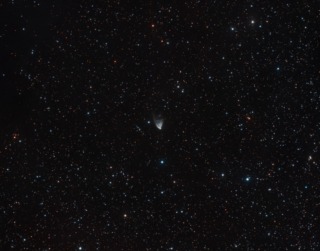
- Constellation: Monoceros
- Right Ascension: 6h 39m 10s
- Declination: +8° 45′
- Distance: 2,500 ly
The nebula patterns and brightness slowly changes over months and years from shadows of dust clouds illuminated by the star R Monocerotis, which in itself encased in a dust cloud. Discovered by William Herschel, and studied by Edwin Hubble who it is named after.
- Details
- Category: Nebulas
Read more: NGC 2261 (2020) Hubble's Variable Nebula
- Telescope: Explore Scientific 127 Refractor
- Camera: ZWO 1600 MM